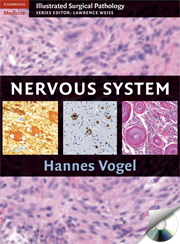Book contents
- Frontmatter
- Contents
- Contributors
- Preface
- Acknowledgments
- 1 Normal Anatomy and Histology of the CNS
- 2 Intraoperative Consultation
- 3 Brain Tumors
- Brain Tumors – An Overview
- Brain Tumor Locations with Respect to Age
- Grading Brain Tumors
- NEUROEPITHELIAL
- TUMORS OF CRANIAL AND PARASPINAL NERVES
- TUMORS OF THE MENINGES
- LYMPHOMAS AND HEMATOPOIETIC NEOPLASMS
- GERM CELL TUMORS
- NONNEOPLASTIC MASSES AND CYSTS
- PATHOLOGY OF THE SELLAR REGION
- METASTATIC NEOPLASMS OF THE CENTRAL NERVOUS SYSTEM
- SKULL AND PARASPINAL NEOPLASMS, NONNEOPLASTIC MASSES, AND MALFORMATIONS
- CNS-RELATED SOFT TISSUE TUMORS
- 4 Vascular and Hemorrhagic Lesions
- 5 Infections of the CNS
- 6 Inflammatory Diseases
- 7 Surgical Neuropathology of Epilepsy
- 8 Cytopathology of Cerebrospinal Fluid
- Index
GERM CELL TUMORS
from 3 - Brain Tumors
Published online by Cambridge University Press: 04 August 2010
- Frontmatter
- Contents
- Contributors
- Preface
- Acknowledgments
- 1 Normal Anatomy and Histology of the CNS
- 2 Intraoperative Consultation
- 3 Brain Tumors
- Brain Tumors – An Overview
- Brain Tumor Locations with Respect to Age
- Grading Brain Tumors
- NEUROEPITHELIAL
- TUMORS OF CRANIAL AND PARASPINAL NERVES
- TUMORS OF THE MENINGES
- LYMPHOMAS AND HEMATOPOIETIC NEOPLASMS
- GERM CELL TUMORS
- NONNEOPLASTIC MASSES AND CYSTS
- PATHOLOGY OF THE SELLAR REGION
- METASTATIC NEOPLASMS OF THE CENTRAL NERVOUS SYSTEM
- SKULL AND PARASPINAL NEOPLASMS, NONNEOPLASTIC MASSES, AND MALFORMATIONS
- CNS-RELATED SOFT TISSUE TUMORS
- 4 Vascular and Hemorrhagic Lesions
- 5 Infections of the CNS
- 6 Inflammatory Diseases
- 7 Surgical Neuropathology of Epilepsy
- 8 Cytopathology of Cerebrospinal Fluid
- Index
Summary
Clinical and Radiological Features
The vast majority of CNS germ cell tumors occur below the age of 25 years with a peak incidence that coincides with puberty and are more common in males. Pineal region germ cell tumors are more frequently found in boys with the opposite tendency in suprasellar examples. Pineal and suprasellar germ cell tumors may occur simultaneously or sequentially. CNS germ cell tumors epitomize the variable incidence of certain neoplasms according to geographic location. They are far more prevalent in Pacific Asia, particularly Japan, but this trend is also evidenced by series from Taiwan and Korea (Nomura, 2001).
Like other extragonadal germ cell tumors, CNS forms tend to occur in the midline. Most occur in the vicinity of the third ventricle, most commonly in the pineal gland followed by the suprasellar region. CNS germ cell tumors may also occur in an intraventricular, diffuse periventricular, or deep cortical gray matter location. Extremely large congenital teratomas may occur, either occupying much of the intracranial space or in the form of sacrococcygeal teratomas. CNS germ cell tumors do not carry WHO grade designations.
A wide variety of clinical manifestations may be seen with CNS germ cell tumors depending on their location and rate of growth. Examples arising in the pineal gland cause obstructive hydrocephalus at the level of the aqueduct of Sylvius, with paralysis of upward gaze and convergence occurring due to compression of the superior colliculi of the midbrain tegmentum, known as Parinaud syndrome.
- Type
- Chapter
- Information
- Nervous System , pp. 239 - 249Publisher: Cambridge University PressPrint publication year: 2009

